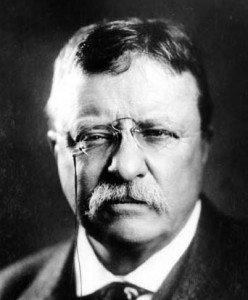 The year was 1912 and Theodore Roosevelt was campaigning for re-election. By the evening of October 14 his campaign had carried him to Milwaukee, Wisconsin where he was to deliver a speech in the city’s public auditorium. As he was leaving his hotel to be driven to the auditorium, a saloonkeeper named John Shrank, approached Roosevelt with his pistol and fired a bullet into Roosevelt’s chest, knocking him down. As bystanders subdued the gunman, Roosevelt stood up, surveyed his blood-spattered shirt and bullet wound, and forced himself to cough, as he had learned from his army days, to see if he was coughing blood due to significant internal bleeding. Finding no blood in his saliva, he demanded that he be driven to the auditorium to deliver his speech.
The year was 1912 and Theodore Roosevelt was campaigning for re-election. By the evening of October 14 his campaign had carried him to Milwaukee, Wisconsin where he was to deliver a speech in the city’s public auditorium. As he was leaving his hotel to be driven to the auditorium, a saloonkeeper named John Shrank, approached Roosevelt with his pistol and fired a bullet into Roosevelt’s chest, knocking him down. As bystanders subdued the gunman, Roosevelt stood up, surveyed his blood-spattered shirt and bullet wound, and forced himself to cough, as he had learned from his army days, to see if he was coughing blood due to significant internal bleeding. Finding no blood in his saliva, he demanded that he be driven to the auditorium to deliver his speech.
The bullet had penetrated a copy of the speech notes he was carrying in his jacket, which had slowed the bullet down enough to save his life. His doctors later found the bullet lodged between two ribs, a half-inch from his lung, and decided it too dangerous to attempt to remove the bullet, so Roosevelt carried the bullet in his chest until his death in 1919.
That night of October 14, 1912, Roosevelt convinced his entourage that his message and the ‘matters at hand’ far exceeded the significance of his own life. He was driven to the auditorium and made his way to the podium to the crowd’s utter shock and disbelief. Still wearing his torn and red-stained shirt, he pulled out his blood-spattered notes and gave his speech:
“I have a message to deliver, and I will deliver it as long as there is life in my body.”
Roosevelt’s speech lasted 90 minutes before being helped to the hospital for treatment.
How can a man believe in something so strongly, that in the moment, the message outweighs the importance of his own life? I believe each of us has been given a distinct message that is uniquely ours – that if that message is not shared, something would be missed.
To truly become who we were born to be, this message must be delivered. Roosevelt’s story is a challenge and a call to discover that unique message, to live a life engaged in a vision bigger than ourselves, where the message becomes more important than the man, and to deliver that message “as long as there is life in our bodies.”
“For we cannot help speaking about what we have seen and heard.” – Peter and John to the Sanhedrin (Acts 4:20)